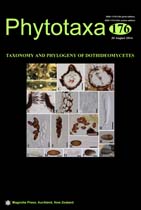Abstract
Asterinella, Cirsosiopsis, Phragmaspidium, Platypeltella, Trichopeltella, Trichopeltum and Trichothyrinula are poorly known ascomycete genera, presently included in the family Microthyriaceae. In this paper the type species of each of these genera were examined and the taxa are redescribed and illustrated with photomicrographs. The taxonomic placement of each genus and their familial position is discussed. Asterinella and Platypeltella has superficial, flattened thyriothecia and superficial hyphae with hyphopodia; the thyriothecia opens by splitting to release the ascospores and these genera should be placed in Asterinaceae. Cirsosiopsis, has strongly flattened, discoid or pulvinate to elongate, carbonaceous ascomata and is transferred to Parmulariaceae. Phragmaspidium has an upper wall comprising neatly arranged radiating cells; the basal layer is poorly developed and thus the genus should be retained in Microthyriaceae. Trichopeltella, Trichopeltum and Trichothyrinula are foliar epiphytes forming extremely thin, relatively large, brown to black, circular to irregular, or root-like, spreading thalli, which cover the thyriothecia and should be placed in Trichopeltinaceae.

